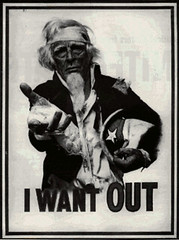“The fate of feral cats remained uncertain Tuesday in Wisconsin, where tallies show a narrow majority of those who attended statewide conservation hearings back the idea of allowing hunters, farmers and others to shoot stray cats without collars as a way to control their numbers. The proposal passed 6,830 to 5,201 in an advisory vote taken in each of the state's 72 counties Monday evening, with the measure generally finding support in rural areas and opposition in urban ones, according to the Wisconsin Department of Natural Resources.”Thus begins a series of steps that have to be taken to allow cats designated as feral to be shot. To raise it to the level of law would require approval from Wisconsin’s Conservation Congress, its Natural Resources Board and the state legislature, but already the fight is bitter. Unsurprisingly, the initiator of the proposal is not a cat fan:
Mark Smith, a La Crosse, Wis., firefighter who traps and hunts, made the feral-cat proposal after he was angered by cats that prowl around his home's birdfeeder.Not the first one. But this guy is proactive:
"If I'm in the woods and see a cat that doesn't have a collar, then I could shoot it," Smith said. "It gives people some leeway if they want to remove cats." He added, "I get up in the morning and if there's new snow, there's cat tracks under my bird feeder . . . I look at them as an invasive species, plain and simple."Now, first and foremost, this is a crackpot idea. It pisses me off that my neighbors sometimes let their dogs run through my yard and leave little presents, but I’m not about to get out and rustle me up some legislation so I can shoot their eyes out. I'm an amateur birdwatcher who keeps feeders in the back yard, but the fact that the squirrels seem to get most of the seed (despite my ingenious efforts), and then go on to kill and eat their eggs and chicks, does not inspire me to head for the bedroom to haul out the side-by-side---we put out the Hav-A-Heart, enticingly laden with peanut butter, and transport the little bastards to a better home.
And though my husband has been an avid hunter for decades, and we both grew up in rural areas, he does not look on hunting seasons as opportunities to take potshots at wandering domestic animals. The one time he did was when we chased a pack of local pet dogs off a doe they had pulled down in our garden, and a German Shepard came at him. Even then, though he would have been within his rights to shoot the dog dead, he only fired a warning. NRA aside, reaching for a gun and killing something does not have to be first and always the answer to every problem.
My own cats have killed a few birds (and voles, mice, and a rabbit) in our yard, and as sad as it made me, I accepted it as part of their nature, and part of Nature, period. This is not an issue of psychopathic criminality, for God’s sake. This is what these animals do! We may be able to minimize it, and take steps to try to make the feeders we put out less feline-accessible, but a cat, like a dog, is a predator. You can’t turn them into something they aren’t.
Second, when dealing with animals normally kept as pets in and near an artificial construct like a human backyard with a bird feeder, there is no such thing as an “invasive species”. There are species we like, and those we don’t. When dogs run in packs--even when they have collars and are clearly pets--they may hunt down game and may even become aggressive towards people, but they are not an invasive species. A snakefish from China in a Pennsylvania river, eating up all the local fish, is an invasive species.
Third, the article states that:
"A feral cat typically is defined as one with no identification collar that fails to show friendly behavior."Only since living in the city did I start putting collars on my cats. In the country, a collar on an indoor/outdoor cat can be tantamount to a death sentence, because in their travels they can be entrapped in trees, brush, or fences when the collar gets entangled. On top of that, some cats are simply not as friendly toward strangers as the catkilling contingent thinks they should be--one of mine hides every time visitors come over. If the definition of “friendly behavior” is "being willing to approach a stranger who's carrying a gun and allowing them to put their hands on you", then damned few of us would qualify as friendly.
Finally, where did the data relied on for this jihad on pussycats come from? Well:
"The DNR hasn't studied the issue, but a scientific basis often cited in the debate comes from a University of Wisconsin professor who estimated in 1996 that there were 1.4 million free-range cats in the state, responsible for at least 7.8 million annual bird deaths."Free-range cats. Don’t they sound delicious? In any case, we now have 1 study from 1 academic about whom we know nothing (including whether he has an axe to grind with felines), on which the whole state has based its preparation for legislation.
This is not about protecting birds. This is about protecting our own feral claim to remaining at the top of the food chain, of retaining our place as the alpha predator, and about trying to maintain backyard fantasies of boutique ecosystems made up of narrowly-acceptable plants and animals steeped in artifice. People like Mark Smith, a hunter who wouldn’t blink at shooting down a pheasant or duck, turn all Jain-like at the idea of a cat having a dinner of bunting. People who yawn and reach for the remote if a story about Abu Ghraib comes on the television, become eloquently exercised over their belief that cats “like to torture” their prey. And people who gladly eat up every Chilean sea bass fillet thay can get their hands on bemoan the impact of cats on the chickadee population. Puh-leeze. Human beings have never lived willingly with other predators, because we do not suffer competition, either from ourselves or other species, and that is the whole genesis of this bruhaha.





No comments:
Post a Comment